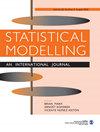两部分非线性潜变量模型的贝叶斯分析:半参数法
IF 1.2
4区 数学
Q2 STATISTICS & PROBABILITY
引用次数: 2
摘要
两部分模型(Two-part model, TPM)是一种广泛应用于半连续数据分析的统计方法。半连续数据可以看作是由两个不同的随机过程产生的:一个决定数据的出现或二进制部分,另一个决定强度或连续部分。在半连续结果作为协变量函数的回归设置中,二进制部分通常通过逻辑回归建模,连续部分通过对数正态模型建模。传统的TPM仍然假设连续部分的对数正态分布,响应之间没有未观察到的异质性,协变量之间没有共线性,这在实际应用中往往是不现实的。在本文中,我们建立了一个半连续和连续多个混合变量的两部分非线性潜变量模型(TPNLVM)。将半连续变量与其他显性变量一起作为潜在因素分析的指标。这降低了回归模型的维数,缓解了潜在的多重共线性问题。我们的TPNLVM可以适应从因子分析中提取的潜在变量之间的非线性关系。为了减轻分布偏差和极端观测值的影响,我们开发了贝叶斯半参数分析程序。放宽了对相关分布的传统参数假设,并利用Dirichlet过程(DP)先验来改进模型拟合。通过利用DP的离散性,我们的方法可以有效地捕获潜在种群的异质性。在贝叶斯范式中,通过马尔可夫链蒙特卡罗(MCMC)抽样方法进行参数估计和模型评估等后验推理。为了便于后验抽样,我们对logistic模型采用Polya-Gamma随机表示。通过模拟研究,我们检查了我们提出的方法的特性和优点,并通过评估治疗对可卡因使用的影响以及检查治疗效果是否受到精神问题的调节来说明我们的方法。本文章由计算机程序翻译,如有差异,请以英文原文为准。
Bayesian analysis of two-part nonlinear latent variable model: Semiparametric method
Two-part model (TPM) is a widely appreciated statistical method for analyzing semi-continuous data. Semi-continuous data can be viewed as arising from two distinct stochastic processes: one governs the occurrence or binary part of data and the other determines the intensity or continuous part. In the regression setting with the semi-continuous outcome as functions of covariates, the binary part is commonly modelled via logistic regression and the continuous component via a log-normal model. The conventional TPM, still imposes assumptions such as log-normal distribution of the continuous part, with no unobserved heterogeneity among the response, and no collinearity among covariates, which are quite often unrealistic in practical applications. In this article, we develop a two-part nonlinear latent variable model (TPNLVM) with mixed multiple semi-continuous and continuous variables. The semi-continuous variables are treated as indicators of the latent factor analysis along with other manifest variables. This reduces the dimensionality of the regression model and alleviates the potential multicollinearity problems. Our TPNLVM can accommodate the nonlinear relationships among latent variables extracted from the factor analysis. To downweight the influence of distribution deviations and extreme observations, we develop a Bayesian semiparametric analysis procedure. The conventional parametric assumptions on the related distributions are relaxed and the Dirichlet process (DP) prior is used to improve model fitting. By taking advantage of the discreteness of DP, our method is effective in capturing the heterogeneity underlying population. Within the Bayesian paradigm, posterior inferences including parameters estimates and model assessment are carried out through Markov Chains Monte Carlo (MCMC) sampling method. To facilitate posterior sampling, we adapt the Polya-Gamma stochastic representation for the logistic model. Using simulation studies, we examine properties and merits of our proposed methods and illustrate our approach by evaluating the effect of treatment on cocaine use and examining whether the treatment effect is moderated by psychiatric problems.
求助全文
通过发布文献求助,成功后即可免费获取论文全文。
去求助
来源期刊

Statistical Modelling
数学-统计学与概率论
CiteScore
2.20
自引率
0.00%
发文量
16
审稿时长
>12 weeks
期刊介绍:
The primary aim of the journal is to publish original and high-quality articles that recognize statistical modelling as the general framework for the application of statistical ideas. Submissions must reflect important developments, extensions, and applications in statistical modelling. The journal also encourages submissions that describe scientifically interesting, complex or novel statistical modelling aspects from a wide diversity of disciplines, and submissions that embrace the diversity of applied statistical modelling.
 求助内容:
求助内容: 应助结果提醒方式:
应助结果提醒方式:


